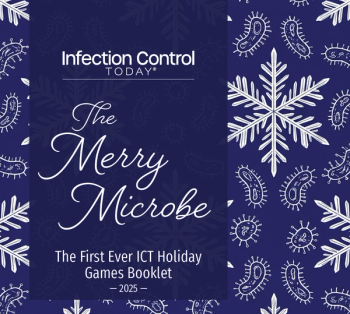
How Does Biofilm Make Candida auris Worse? An Expert Explains
A relatively new threat, the Candida auris fungus has become a dangerous agent due to its ability to form biofilms, which help it survive and spread infections within the environment.
Nicole Slacik, BS, executive vice president of health care for EvaClean Infection Prevention Solutions, spoke with Infection Control Today (ICT) about Candida auris (C auris) and how biofilms make it and other “superbugs” even more dangerous.
Slacik is an expert in health care education and clinical training. She works with health systems across the country to improve patient safety by standardizing cleaning and enhancing processes. As the leader of EvaClean’s PurExcellence Program, Slacik has helped health care partners increase compliance and achieve high Leapfrog Hospital Safety Grades. In addition, she is the founder of Bextera Health and provides healthcare advisory services. Slacik is highly regarded as a clinical thought leader and has extensive knowledge of immunology, biology, nutraceuticals, and pharmaceuticals. She has worked with top-ranking companies such as Johnson & Johnson, where she received both the Horizon and Sighting Awards. Slacik is certified in clinical research by the Association of Clinical Research Professionals (CCRA) and has received training in infection prevention.
ICT: Please briefly explain what C auris is, what biofilm is, and how C auris survives in biofilm.
Nicole Slacik, BS: C auris is a fungus that can cause severe infections. It has a high mortality rate of 30% to 60%, particularly among patients with severe medical conditions in hospitals and long-term care facilities.
Microbes adhere to a surface and create protective biofilms as a barrier against the external environment, including many antimicrobial agents. Moreover, different pathogens often colonize the same biofilm and exchange antibiotic-resistant genes, making infections more difficult to treat. Organisms living in biofilms can be up to 1,000-fold more antibiotic resistant and 1,500 times less susceptible to disinfectants.
Only recently has C auris fungi emerged as a dangerous biofilm-associated agent. Biofilms aid its survival and persistence in the environment and are a mechanism for infection transfer.
ICT: Additionally, what other microorganisms are able to survive in a biofilm?
NS: The list of microbes, including gram-positive/gram-negative bacteria and fungi, that can cling to surfaces and medical devices in biofilms is long and diverse. In fact, the “superbugs” that contribute to most health care-associated infections (HAIs) can persist in armor-like biofilms: Methicillin-resistant Staphylococcus aureus (MRSA); Acinetobacter baumannii (A baumannii); Carbapenem-resistant Enterobacteriaceae (CRE); Vancomycin-resistant enterococci (VRE); and C auris. Foodborne aside, biofilm-forming organisms also includeStaphylococcus aureus (S aureus); Klebsiella pneumoniae (K pneumoniae); Pseudomonas aeruginosa (P aeruginosa); Staphylococcus epidermidis (S epidermidis);Escherichia coli (E coli); andClostridium difficile (C difficile).
The list of surfaces where biofilms persist is also long and diverse. In addition to countertops and other hard surfaces, it includes floors, stainless steel, plastic, textiles, and portable medical equipment shared between patients.
Given the alarming rate at which C auris has been spreading, is biofilm a contributing factor?
NS: Absolutely. According to the NIH, 65% - 80% of chronic (recurring) infections are biofilm-related. Biofilm reservoirs enable C auris to persist on surfaces and devices longer—from weeks to months—which can subsequently lead to outbreaks in health care settings.
Studies have shown that a single touch can transfer biofilm bacteria and fungi to a health care worker’s hands, even with gloves, which can then be transferred to patients and contaminate multiple other surfaces.
ICT: If so, what measures can be taken to address it?
NS: If C auris has been identified, fast response and aggressive infection control measures, including screening, isolation, and special precautions, are crucial to preventing spread. More proactive strategies for addressing C auris and biofilm include:
- Educating staff to raise awareness of the dangers of surface biofilms, the organisms they harbor, and the necessity for effective cleaning and disinfection to eradicate them.
- Targeted protocols focused on cleaning and disinfecting high-risk surfaces most prone to biofilm formation, including reusable and shared equipment.
- Enhanced processes using advanced technologies such as electrostatic sprayers that extend disinfection reach to more areas.
- The dual efficacy of the selected disinfectant is critical to mitigating biofilm and MDROs. The biocidal agent should be EPA registered as effective against biofilm and have efficacy claims against a broad spectrum of pathogens, including C auris.
ICT: Recently, the EPA approved the updated master label for PurOne, a disinfectant from EvaClean Infection Prevention Solutions, to include List P. This is significant because PurOne is one of only a few products registered as effective against biofilm and C auris. Can you explain what List P is and why this announcement is important?
NS: List P includes antimicrobial products EPA registered for claims against C. auris. There are currently 38 products from 13 chemical manufacturers on List P. Unfortunately, there is no biofilm list, and claims can only be found on chemical master labels. However, cross-referencing labels with List P indicates that only some products with both claims can be used for disinfection facility-wide.
It’s widely known that most traditional disinfectants cannot penetrate biofilms, let alone inhibit biofilm regrowth. Even if a product has biofilm and C auris claims, it may pose health hazards. For example, quaternary ammonium compounds (QACs) and sodium hypochlorite (bleach) are 2 commonly used chemicals in health care. QACs do not meet the EPA standard for biofilms and have raised serious health concerns; while bleach has both claims, its respiratory effects are well documented.
Ultimately, PurOne’s NaDCC chemistry is 1 of the rare few that has both biofilm and C auris claims while having a 0/0/0 hazard rating, a neutral pH, and the EPA’s lowest toxicity category IV.
ICT: Has there been a study regarding this approval, and if so, can you provide a summary?
NS: Several studies have confirmed the efficacy of PurOne’s NaDCC chemistry against biofilms and C auris independently, as well as C auris biofilms specifically.
American Journal of Infection Control (AJIC) published a study from NYU Langone Health to assess the efficacy of 3 sporicidal disinfectants (NaDCC, PAA/Hydrogen Peroxide, and Electrolyzed Water) against surface-persistent C auris. Results determined that NaDCC (from EvaClean) applied with the standard microfiber cloth and mop method plus an electrostatic sprayer was the most effective chemical disinfectant for reducing colony counts.Current Fungal Infection Reports published a peer-reviewed paper on the efficacy of disinfectants against C auris biofilms, which showed NaDCC achieved a 7-log reduction at 1000ppm, much less than the 4306ppm typically used in health care.- According to ASTM E2871, NaDCC, in combination with a surfactant (PurOne), improves efficacy against biofilm bacteria as it aids penetration of the protective layer.
InfectionControl.tips published a peer-reviewed paper entitled The Impact of a Continuously Active Disinfectant on Bacterial Surface Concentrations and Biofilm Growth which confirmed NaDCC reduces surface bacteria, including disinfectant-resistant C difficile spores, and inhibits biofilm regrowth for 24 hours.Infection Control & Hospital Epidemiology published a study to determine biofilm susceptibility to biocide, and of the 11 chemistries tested, NaDCC was 1 of only 2 that lowered both direct and cross-transmission of biofilm bacteria and prevented recovery after treatment. PAA was also effective but is considered a hazardous chemical.
ICT: Is there anything else you would like to add?
NS: Yes—Overall, we need to improve how we disinfect health care facilities and identify and screen patients. This includes educating health care professionals on C auris colonization, infection, and transmission. However, there is a lack of visual references for identifying C auris. Clinical education on dermatological infections should always include images of what an infection looks like on all skin color types. Special precautions should be taken to help obviate inequity in health care and missed opportunities to prevent HAIs.
References:
- American Society for Microbiology. The role of bacterial biofilms in antimicrobial resistance. March 6, 2023. Accessed July 5, 2023.
https://asm.org/Articles/2023/March/The-Role-of-Bacterial-Biofilms-in-Antimicrobial-Re - Chowdhury D, Tahir S, Legge M, Hu H, Prvan T, Johani K, Whiteley GS, Glasbey TO, Deva AK, Vickery K. Transfer of dry surface biofilm in the healthcare environment: the role of healthcare workers' hands as vehicles. Healthcare Infection Society. J Hosp InfectJuly 2, 2018. Accessed July 5, 2023.
https://www.journalofhospitalinfection.com/article/S0195-6701(18)30356-6/fulltext - Venkatesan N, Perumal G, Doble M. Bacterial Resistance in Biofilm-associated Bacteria. Future Microbiol. October 30, 2015. Accessed July 5, 2023.
https://pubmed.ncbi.nlm.nih.gov/26517598/ - Vickery K, Deva A, Jacombs A, Allan J, Valente P, Gosbell IB. Presence of Biofilm Containing Viable Multi-resistant Organisms Despite Terminal Cleaning on Clinical Surfaces in an Intensive Care Unit. Healthcare Infection Society. J Hosp Infect. September 7, 2011. Accessed July 5, 2023.
https://www.journalofhospitalinfection.com/article/S0195-6701(11)00319-7/fulltext - Hu H, Johani K, et al. Intensive care unit environmental surfaces are contaminated by multidrug-resistant bacteria in biofilms. Healthcare Infection Society. J Hosp Infect. June 25, 2015. Accessed July 5, 2023.
https://www.journalofhospitalinfection.com/article/S0195-6701(15)00258-3/fulltext - Almatroudi A. Staphylococcus aureus dry-surface biofilms are not killed by sodium hypochlorite: implications for infection control. Healthcare Infection Society. J Hosp Infect.April 12, 2016. Accessed July 5, 2023.
https://www.journalofhospitalinfection.com/article/S0195-6701(16)30008-1/fulltext - Otter JA, Vickery K, Walker JT, et al. Surface-attached cells, biofilms and biocide susceptibility: implications for hospital cleaning and disinfection. Healthcare Infection Society. J Hosp Infect. September 30, 2014. Accessed July 5, 2023.
https://www.journalofhospitalinfection.com/article/S0195-6701(14)00289-8/fulltext - Boyce J. Environmental Contamination Makes an Important Contribution to Hospital Infection. Healthcare Infection Society. The Journal of Hospital Infection. Accessed July 5, 2023.
https://www.journalofhospitalinfection.com/article/S0195-6701(07)60015-2/pdf - Chowdhury D, Rahman A, Hu H, et al. Effect of disinfectant formulation and organic soil on the efficacy of oxidizing disinfectants against biofilms. Healthcare Infection Society. J Hosp Infect. September 2019. Accessed July 5, 2023.
https://www.sciencedirect.com/science/article/pii/S0195670118305565 - Centeleghe I. Understanding the Resilience of Dry Surface Biofilms to Disinfection. Cardiff University. (2022). Accessed July 5, 2023.
https://orca.cardiff.ac.uk/id/eprint/153115/1/2022centelegheiphd.pdf - Gately M, Hodgson M, Finn S. Biofilm—the real challenge for infection prevention. American Journal of Infection Control. 2017;45(6):S57. doi:10.1016/j.ajic.2017.04.085
- Solomon S, Stachel A, Kelle A, Sterling S, Aquero-Rosenfeld M, Phillips M. The Evaluation of Electrolyzed Water, Sodium dichloroisocyanurate, and Peracetic acid with Hydrogen peroxide for the Disinfection of Patient Room Surfaces. American Journal of Infection Control. April 2023. Accessed July 5, 2023.
https://www.ajicjournal.org/article/S0196-6553(22)00507-7/pdf - Reynolds K. The Impact of a Continuously Active Disinfectant on Bacterial Surface Concentrations and Biofilm Growth. InfectionControl.tips. June 1, 2021. Accessed July 5, 2023.
https://infectioncontrol.tips/2021/06/01/impact-of-a-continuously-active-disinfectant-on-bacterial-surface-concentrations-and-biofilm-growth/ - Ahmad S., Asadzadeh M. Strategies to Prevent Transmission of Candida auris in Healthcare Settings. Curr Fungal Infect Rep. January 26, 2023. Accessed July 5, 2023.
https://link.springer.com/article/10.1007/s12281-023-00451-7 - Ledwoch K, Magoga M, Williams D, Fabbri S, et al. Is a reduction in viability enough to determine biofilm susceptibility to a biocide? Infect Control Hosp Epidemiol.(2021). Accessed July 5, 2023.
https://www.cambridge.org/core/journals/infection-control-and-hospital-epidemiology/article/abs/is-a-reduction-in-viability-enough-to-determine-biofilm-susceptibility-to-a-biocide/E80C2A83AE2561688FEDB637AEEE3E9E
Newsletter
Stay prepared and protected with Infection Control Today's newsletter, delivering essential updates, best practices, and expert insights for infection preventionists.






